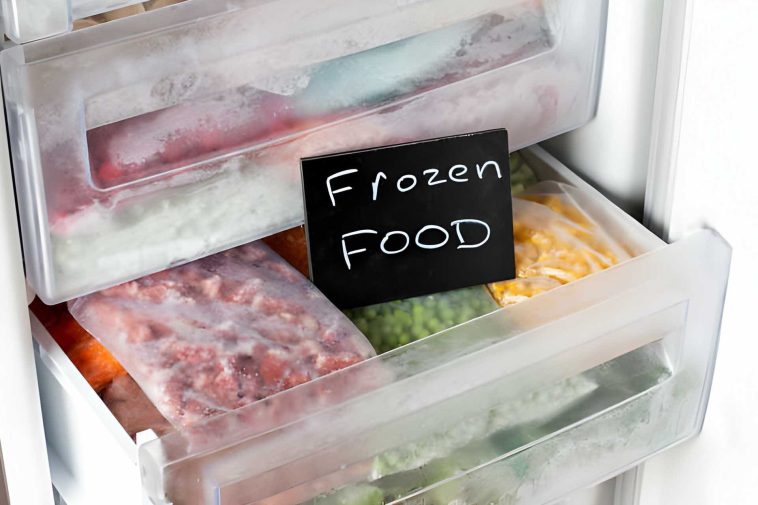Freezing food is more than just a matter of convenience; it’s a strategic approach to smart kitchen management. The importance of freezing foods lies in its multifaceted benefits, which extend far beyond just prolonging the shelf life of your groceries. Here are some key advantages:
- Reducing Waste: Freezing food is an effective way to combat food waste. By freezing leftovers or excess fresh produce, you can prevent spoilage and discard less food. This practice is not only eco-friendly but also respects the resources that go into food production.
- Saving Money: Utilizing your freezer allows you to buy in bulk, take advantage of sales, and store seasonal items for off-season use. This can lead to significant savings on your grocery bills, as frozen foods can be stored for extended periods without losing their quality.
- Convenience: Having a variety of frozen foods on hand simplifies meal planning. It enables quick meal preparation, reduces the frequency of grocery shopping trips, and ensures you always have ingredients available for a healthy, home-cooked meal.
In essence, the art of freezing foods is a practical skill that enhances the efficiency of your kitchen, contributes to a sustainable lifestyle, and supports your budget-friendly goals.
Unexpected Freezer-Friendly Foods
Avocados
- How to Freeze: To freeze avocados, begin by slicing them in half and removing the pit. Brush the halves with lemon juice to prevent browning. Wrap each half tightly in plastic wrap and place them in a freezer-safe bag, squeezing out as much air as possible before sealing.
- Uses After Thawing: Thawed avocados are perfect for making guacamole or spreads. They can also be used in smoothies or as a creamy addition to sandwiches and salads.
Butter
- Freezing Process: Butter can be frozen in its original packaging. For added protection, wrap it in aluminum foil or place it inside a freezer bag. This method keeps the butter fresh for several months.
- Tips for Thawing and Use: To thaw, leave the butter in the refrigerator overnight or use a microwave on a low setting for short intervals. Thawed butter is ideal for baking and cooking, but it’s best to use fresh butter for applications where its flavor is prominent, like spreading on bread.
Lemon or Orange Slices
- Freezing Method: Freeze lemon or orange slices by placing them on a baking sheet lined with parchment paper. Once frozen, transfer the slices to a freezer bag. This prevents them from sticking together and allows you to use individual slices as needed.
- Culinary Uses: Frozen lemon or orange slices are great for flavoring water, teas, and cocktails. They can also be used in cooking, adding a zesty flavor to marinades, baked goods, and sauces.
Other Fresh Fruits
- Preparation for Freezing: Wash, dry, and slice fruits before freezing. Spread them out on a baking sheet to freeze individually, then transfer to a freezer bag. This prevents the pieces from clumping together.
- Health Benefits: Freezing fruits preserves most of their nutrients, including vitamins and antioxidants. Frozen fruits are excellent in smoothies, yogurts, and desserts. They provide the same health benefits as fresh fruits and are a convenient option for out-of-season varieties.
Dried Chili Peppers
- Best Way to Freeze: Dried chili peppers should be placed in a freezer-safe bag or container. Removing as much air as possible before sealing will help maintain their flavor and prevent freezer burn.
- Using Thawed Peppers: Thawed dried chili peppers can be rehydrated by soaking in warm water. They are then ready to be used in various recipes, such as sauces, stews, and marinades, adding a rich depth of flavor and heat to your dishes.
Buttermilk and Half & Half
- Freezing Techniques: Buttermilk and half & half can be frozen in their original containers if there’s enough headspace for expansion; otherwise, pour into airtight containers or ice cube trays. Label with the date to keep track of freshness.
- Recipes Incorporating Thawed Products: Thawed buttermilk is excellent in pancakes, waffles, and marinades, while half & half can be used in creamy soups, sauces, and coffee. Note that the texture may change slightly, making them better suited for cooking rather than raw consumption.
Pesto
- Preservation by Freezing: Pesto freezes exceptionally well. Pour into ice cube trays or small containers, and drizzle a thin layer of olive oil on top to prevent oxidation. Once frozen, transfer the cubes to a freezer bag.
- Creative Uses in Meals: Thawed pesto is versatile in the kitchen. Stir into pasta, spread on sandwiches, or use as a flavorful base for pizzas. It can also be a vibrant addition to salad dressings or a quick flavor boost for grilled meats and vegetables.
Corn on the Cob
- Effective Freezing Methods: Blanch corn on the cob in boiling water for a few minutes, then plunge into ice water to stop the cooking process. Dry thoroughly before freezing in airtight bags.
- Serving Suggestions Post-Freezing: Thawed corn on the cob can be grilled, boiled, or roasted. It retains its sweet flavor and crisp texture, making it a great side dish for barbecues and picnics. You can also cut the kernels off the cob for use in salads, soups, and casseroles.
Diced Onions and Garlic
- Freezing Process: Chop onions and garlic, spread them on a baking sheet to freeze individually, and then transfer to freezer bags. This prevents them from forming clumps and allows for easy portioning.
- Cooking with Frozen Onions and Garlic: Use directly from the freezer in sautéing, soups, and stews. They retain much of their flavor and save significant prep time. Frozen onions and garlic are especially handy for busy weeknights when time is of the essence.
Eggs
- How to Freeze Eggs Safely: Crack eggs into a bowl, gently whisk to blend yolks and whites, and pour into freezer-safe containers or ice cube trays. Avoid freezing eggs in their shells.
- Recipes Using Frozen Eggs: Thawed eggs are suitable for scrambled eggs, omelets, baking cakes, and cookies. They should be thawed overnight in the refrigerator and used as soon as possible. While the texture may change slightly, making them less ideal for poaching or boiling, they work wonderfully in most cooked dishes.
FAQs
What are some foods you can freeze?
- Almost any food can be frozen, with the right technique. Commonly frozen items include fruits, vegetables, meat, fish, dairy products like cheese and butter, and cooked dishes such as soups and casseroles. Freezing is a versatile method that can extend the life of many foods, preserving their quality and nutritional value.
Is there any food you can’t freeze?
- Certain foods do not freeze well due to texture changes or moisture content. These include high-water content vegetables like lettuce and cucumbers, which can become limp and waterlogged. Cream-based sauces and gravies may separate and become grainy. Additionally, foods like mayonnaise, cream cheese, and sour cream can also separate and become unappealing.
What foods can you flash freeze?
- Flash freezing is ideal for small, individual items like berries, sliced fruits, meatballs, and cookie dough. This method involves freezing foods quickly at a very low temperature, which prevents the formation of large ice crystals and helps maintain texture and flavor. Flash-frozen foods are convenient as they can be used in portions without defrosting the entire batch.
What foods can be stored in the freezer?
- The freezer can store a wide variety of foods, including raw and cooked meats, seafood, bread, pastries, dairy products, fruits, vegetables, and prepared meals. Freezing slows down the deterioration process by inhibiting the growth of microorganisms and enzyme activity that cause spoilage. Proper packaging is key to preventing freezer burn and preserving quality.
Freezing is an excellent way to ensure that you always have ingredients on hand, reduce trips to the grocery store, and save money by buying in bulk. By understanding the right methods to freeze various foods, you can maintain their quality and enjoy them at your convenience. Remember, freezing does not sterilize food but significantly slows down the growth of microorganisms, making it a safe and effective way to store food.






Comments
Loading…